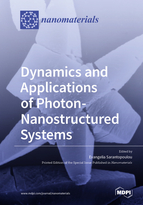Dynamics and Applications of Photon-Nanostructured Systems
A special issue of Nanomaterials (ISSN 2079-4991).
Deadline for manuscript submissions: closed (30 April 2020) | Viewed by 77657
Special Issue Editor
Interests: biophysics; cancer cells; nanomedicine; complexity in biosystems; nanomechanics
Special Issues, Collections and Topics in MDPI journals
Special Issue Information
Dear Colleagues,
Nanotechnologies are tracking different stages of novel technological applications by integrating molecular functionalities with the macro-world. Not to mention the scientific research on metamaterials and nanorobotic systems, photons, besides their use in almost all aspects of modern life, carry an immense amount of quantum information, which, when combined with nanoscience and nanotechnological tools, allows one to visualise novel technological applications such as quantum computing. Photonics for nano-applications refers to the research and development of novel nanodevices, functionalities, and applications based on photonic nanostructured and photon-shaped materials or photon–nanomaterial interactions having specific and tailored functionalities. Therefore, not only the submission of research articles with proof-of-concept demonstrations is encouraged for this Special Issue, but also the submission of articles including upcoming and future ideas with a strong interdisciplinary fundamental, theoretical, and applied character, over a wide range of thematic areas in physics, chemistry engineering, and biology, is welcome. Among other classical subjects of photonic nanotechnology, we invite articles on photon surface processing and interphases, nano- and non-equilibrium thermodynamic, chaos and non-linear behavior at the nanoscale, quantum and nano-effects in biological systems and nanorotors.
Dr. Evangelia Sarantopoulou
Guest Editor
Manuscript Submission Information
Manuscripts should be submitted online at www.mdpi.com by registering and logging in to this website. Once you are registered, click here to go to the submission form. Manuscripts can be submitted until the deadline. All submissions that pass pre-check are peer-reviewed. Accepted papers will be published continuously in the journal (as soon as accepted) and will be listed together on the special issue website. Research articles, review articles as well as short communications are invited. For planned papers, a title and short abstract (about 100 words) can be sent to the Editorial Office for announcement on this website.
Submitted manuscripts should not have been published previously, nor be under consideration for publication elsewhere (except conference proceedings papers). All manuscripts are thoroughly refereed through a single-blind peer-review process. A guide for authors and other relevant information for submission of manuscripts is available on the Instructions for Authors page. Nanomaterials is an international peer-reviewed open access semimonthly journal published by MDPI.
Please visit the Instructions for Authors page before submitting a manuscript. The Article Processing Charge (APC) for publication in this open access journal is 2900 CHF (Swiss Francs). Submitted papers should be well formatted and use good English. Authors may use MDPI's English editing service prior to publication or during author revisions.
Keywords
- Photonic nanoscience and nanotechnologies and surface processing
- Photonic quantum and size effects at the nanoscale
- Photonic generation of nanoparticles and nano-objects
- Laser and light processing of material and applications at the nanoscale
- Photonic surface functionalization
- Biophotonics
- Non-equilibrium systems, chaos, and non-linear dynamics
- Photonic self-assembly







